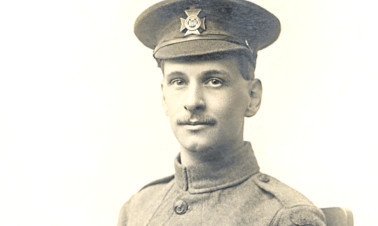
German troops put on a panto for British soldiers wearing women’s clothing they had looted.
The cross-dressing First World War Christmas truce secret has emerged in eye-opening letters passed to The Sunday Post.
They reveal British servicemen were entertained by enemy soldiers wearing blouses and skirts believed to have been nicked from a French farmhouse.
It has long been known that the opposing sides played football during the Christmas Truce of 1914. But this is the first time details of the forgotten Christmas panto have emerged.
Former police officer Bob Brookes, 58, from Maybole, South Ayrshire, discovered the detail in letters his granddad Bernard sent home from France.
“It was the last thing I expected to find,” he said. “You can only imagine the men were sick of the death and carnage and were desperate for an escape through entertainment. It must have seemed like a pantomime to my granddad and the other British soldiers.”
Bernard, 22, was a sergeant with the Queen’s Westminster Rifles when he sent the letters back. He survived the war and died in 1962, aged 69.
One letter explains: “Many of the Germs(sic) had costumes on which had been taken from houses nearby, and one fellow had a blouse, skirt, top hat and umbrella which caused much merriment.”
The troops even exchanged addresses and promised to write to each other at the end of the war if they “came through safely”.
The tale is featured in a new book by Bob’s aunt, Una Barrie. All profits from sales of A Signaller’s War will be donated to the British Legion.
First World War expert Alan Cleaver is delighted the new panto detail has emerged.
“I’d heard stories of pantomimes and dressing up on the Western Front but never seen written evidence until now,” he said. “His account is particularly interesting as it confirms men dressing in fancy dress and women’s clothing during the truce.”
Another letter revealed the story of a German who defected to find his young bride he left behind in Britain.
A poignant note from Captain John Stansfeld, who was in command of the 2nd Battalion of the Gordon Highlanders reveals a 100-year-old love story.
John, who lived at Dunninald, Montrose, tells the story of a young conscript caught up in war and drafted into the German army after marrying his love.
“Tonight a German came across and deserted to our side. He had been talking to some of Scots Guards on Xmas Day and took advantage of the truce to come right in. He is married to an English girl and lives in Devonshire.”
Captain Stansfield’s great-grandson Edward, said: “We may never know what happened to this young German defector.”

Enjoy the convenience of having The Sunday Post delivered as a digital ePaper straight to your smartphone, tablet or computer.
Subscribe for only £5.49 a month and enjoy all the benefits of the printed paper as a digital replica.
Subscribe